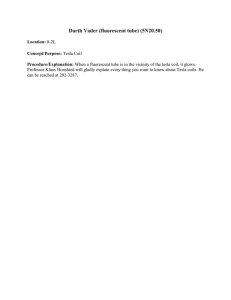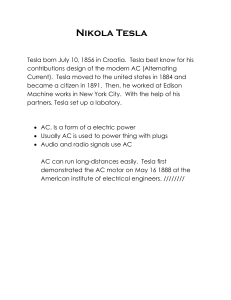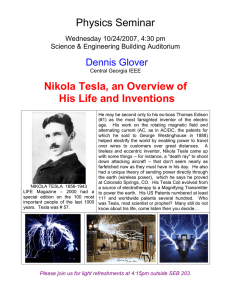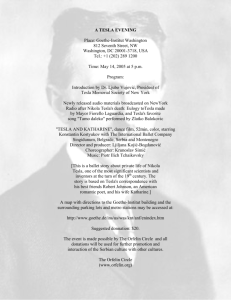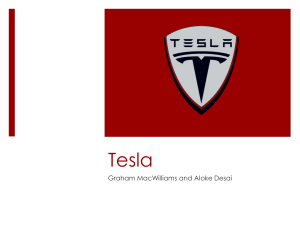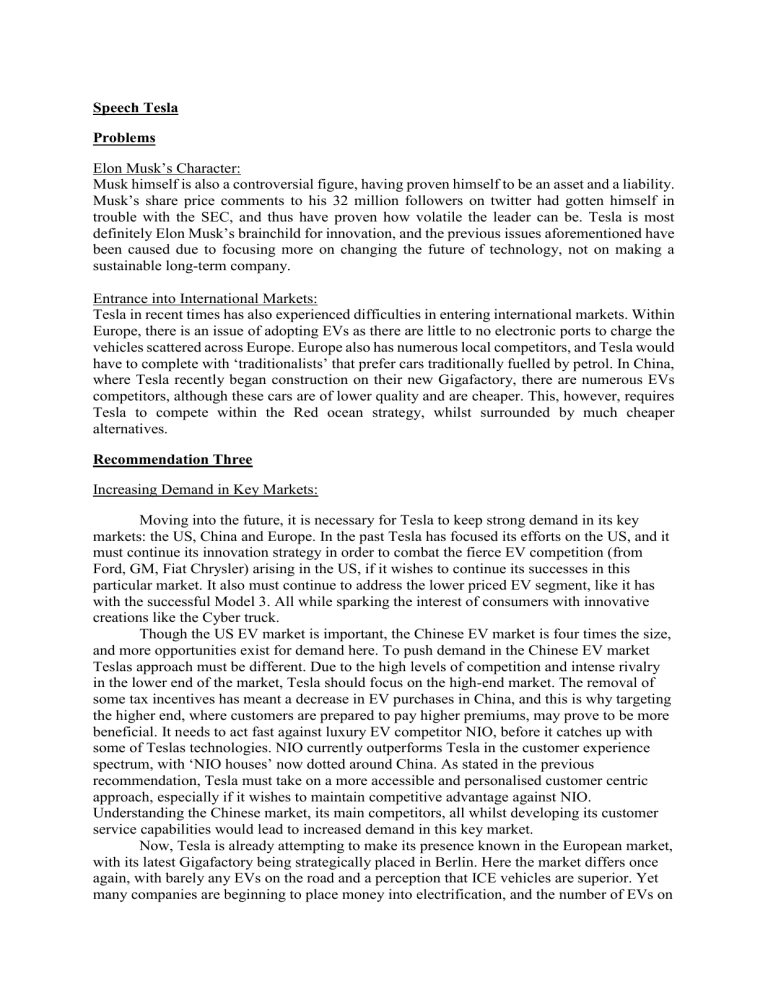
Speech Tesla Problems Elon Musk’s Character: Musk himself is also a controversial figure, having proven himself to be an asset and a liability. Musk’s share price comments to his 32 million followers on twitter had gotten himself in trouble with the SEC, and thus have proven how volatile the leader can be. Tesla is most definitely Elon Musk’s brainchild for innovation, and the previous issues aforementioned have been caused due to focusing more on changing the future of technology, not on making a sustainable long-term company. Entrance into International Markets: Tesla in recent times has also experienced difficulties in entering international markets. Within Europe, there is an issue of adopting EVs as there are little to no electronic ports to charge the vehicles scattered across Europe. Europe also has numerous local competitors, and Tesla would have to complete with ‘traditionalists’ that prefer cars traditionally fuelled by petrol. In China, where Tesla recently began construction on their new Gigafactory, there are numerous EVs competitors, although these cars are of lower quality and are cheaper. This, however, requires Tesla to compete within the Red ocean strategy, whilst surrounded by much cheaper alternatives. Recommendation Three Increasing Demand in Key Markets: Moving into the future, it is necessary for Tesla to keep strong demand in its key markets: the US, China and Europe. In the past Tesla has focused its efforts on the US, and it must continue its innovation strategy in order to combat the fierce EV competition (from Ford, GM, Fiat Chrysler) arising in the US, if it wishes to continue its successes in this particular market. It also must continue to address the lower priced EV segment, like it has with the successful Model 3. All while sparking the interest of consumers with innovative creations like the Cyber truck. Though the US EV market is important, the Chinese EV market is four times the size, and more opportunities exist for demand here. To push demand in the Chinese EV market Teslas approach must be different. Due to the high levels of competition and intense rivalry in the lower end of the market, Tesla should focus on the high-end market. The removal of some tax incentives has meant a decrease in EV purchases in China, and this is why targeting the higher end, where customers are prepared to pay higher premiums, may prove to be more beneficial. It needs to act fast against luxury EV competitor NIO, before it catches up with some of Teslas technologies. NIO currently outperforms Tesla in the customer experience spectrum, with ‘NIO houses’ now dotted around China. As stated in the previous recommendation, Tesla must take on a more accessible and personalised customer centric approach, especially if it wishes to maintain competitive advantage against NIO. Understanding the Chinese market, its main competitors, all whilst developing its customer service capabilities would lead to increased demand in this key market. Now, Tesla is already attempting to make its presence known in the European market, with its latest Gigafactory being strategically placed in Berlin. Here the market differs once again, with barely any EVs on the road and a perception that ICE vehicles are superior. Yet many companies are beginning to place money into electrification, and the number of EVs on the road is looking to increase in Europe. Tesla must act as a first mover here, so it can gain customer commitment, gain the market share and shape industry standards here. Creating a strategic alliance with a company like VW (which is widely known in Europe) could prove beneficial to Tesla, particularly in improving customer acceptance of their EVs. VW is also bound to be a significant competitor in the European EV market in the future as it has dedicated $30 billion by 2023 to produce fully connected EVs. If it cannot create an alliance with VW it will have to go up against the automotive giant. Implications: Increasing demand, especially in China and Europe will require substantial capital. Developing its customer service and face-to-face operations will prove complicated and expensive. In Europe, there are still difficulties to accurately estimate returns as first movers in this market, as well as customer acceptance. Further, building the necessary charging infrastructure is costly, yet necessary, due to the number of people without private charging facilities in both China and Europe. Finally, the effects of Covid-19 must be considered as the economy in these markets continues to struggle, and this could cause ongoing issues in demand. Conclusion: Overall, relevant to each market, Tesla must continue its differentiated business strategy in order to continue as market leader. Maintaining the uniqueness of its products for a premium niche segment often at premium prices will eliminate the competition, which still tends to resemble traditional vehicles, whilst maintaining continued demand.
